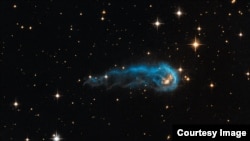The Hubble space telescope has spotted what astronomers are calling a “cosmic caterpillar.”
The object, called IRAS 20324+4057, is actually a light-year-long knot of interstellar gas and dust scientists call a “protostar.” They said the object is “in a very early evolutionary stage.”
According to the Hubble website, harsh winds from extremely bright stars are blasting ultraviolet radiation and sculpting the gas and dust into the long shape.
Those bright stars are 65 of the hottest known to exist, classified as O-type stars. They are located 15 light-years away from IRAS 20324+4057, toward the right edge of the image.
These stars, along with 500 that are less bright but still highly luminous B-type stars, make up what is called the Cygnus OB2 Association. Collectively, scientists say the Association is thought to have a mass more than 30,000 times that of our Sun.
Protostars in this region should eventually become young stars, the scientists say, with final masses about one to 10 times that of the Sun. But if the radiation from the nearby bright stars destroys the gas envelope before the protostars finish collecting mass, their final masses may be reduced.
Spectroscopic observations of the central star within IRAS 20324+4057 show that it is still collecting material quite heavily from its outer envelope and is expected to bulk up in mass. Scientists studying the Hubble data say that it is too early to say whether the new star would be a "heavy-weight" or a "light-weight" star with respect to its mass.
This image of IRAS 20324+4057 is a composite of Hubble Advanced Camera for Surveys data taken in 2006, and ground-based data from the Isaac Newton Telescope in 2003. The object lies 4,500 light-years away in the constellation Cygnus.
The object, called IRAS 20324+4057, is actually a light-year-long knot of interstellar gas and dust scientists call a “protostar.” They said the object is “in a very early evolutionary stage.”
According to the Hubble website, harsh winds from extremely bright stars are blasting ultraviolet radiation and sculpting the gas and dust into the long shape.
Those bright stars are 65 of the hottest known to exist, classified as O-type stars. They are located 15 light-years away from IRAS 20324+4057, toward the right edge of the image.
These stars, along with 500 that are less bright but still highly luminous B-type stars, make up what is called the Cygnus OB2 Association. Collectively, scientists say the Association is thought to have a mass more than 30,000 times that of our Sun.
Protostars in this region should eventually become young stars, the scientists say, with final masses about one to 10 times that of the Sun. But if the radiation from the nearby bright stars destroys the gas envelope before the protostars finish collecting mass, their final masses may be reduced.
Spectroscopic observations of the central star within IRAS 20324+4057 show that it is still collecting material quite heavily from its outer envelope and is expected to bulk up in mass. Scientists studying the Hubble data say that it is too early to say whether the new star would be a "heavy-weight" or a "light-weight" star with respect to its mass.
This image of IRAS 20324+4057 is a composite of Hubble Advanced Camera for Surveys data taken in 2006, and ground-based data from the Isaac Newton Telescope in 2003. The object lies 4,500 light-years away in the constellation Cygnus.









